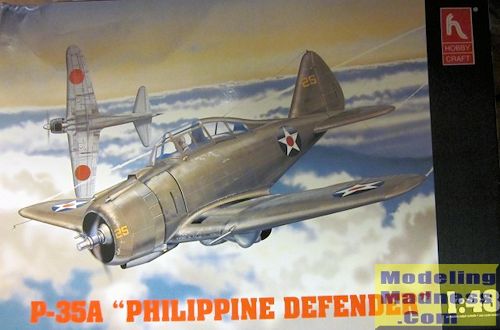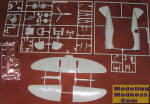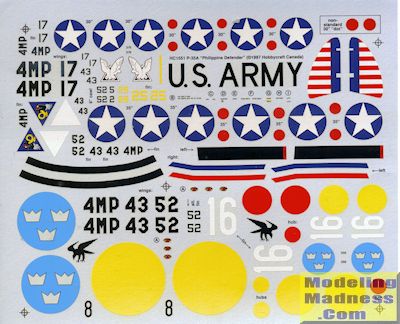
| KIT #: | HC 1551 |
| PRICE: | $ |
| DECALS: | Five options |
| REVIEWER: | Scott Van Aken |
| NOTES: |

| HISTORY |
The first P-35s were delivered to the 1st Pursuit Group (27th, 71st and 94th PS) stationed at Selfridge Field in Michigan. The aircraft used a wet wing to save weight and ground personnel quickly learned about the persistent fuel leaks. The P-35's performance was poor even by contemporary standards and, although USAAC aviators appreciated the aircraft's ruggedness, it was already obsolete by the time deliveries were finished in 1938.
On 18 June 1940, United States declared an embargo against exporting weapons to any nation other than the United Kingdom. Optimistically, Republic continued to manufacture EP-106s which, by the 24 October 1940 order, 60 were taken over by the USAAC as the P-35A. The aircraft were re-armed to American standards with a pair of 0.50 in machine guns that fired through the propeller, but retained the Swedish specification of a 0.30 in machine gun mounted in each wing. Flight instruments were metric, and both their labeling and flight manuals written in Swedish. Of these, three aircraft were kept in United States as instructional airframes for mechanics. Six P-35As were delivered to Ecuador to form the first combat unit, the Escuadrilla de Caza. The remainder were sent to the Far East Air Force in the Philippines beginning in February 1941. Eventually all pilots of the three pursuit squadrons on Luzon transitioned to the P-35A from the P-26. About 10 of these were lost in accidents. The P-35s were used primarily as gunnery trainers by all three squadrons because of a critical shortage of .50-caliber ammunition in the Far East Air Force, placing a strain on the engines of all the aircraft since no replacement engines were available. In October 1941, the P-35s were earmarked for transfer to the Philippine Army Air Corps after sufficient Curtiss P-40 Warhawks were received by the FEAF.
In November 1941, after the 3rd and 17th PS received new P-40E aircraft, most of their P-35As were passed to two newly arrived squadrons attached to the group, the 21st and 34th PS, with the latter receiving most. The 21st PS received its P-40Es on the eve of war and transferred its few P-35s to the 34th Pursuit Squadron, which then had nearly a full squadron. It then fought with them in the futile defense of the islands in December 1941, initially at Del Carmen Field. They were hopelessly outclassed by the Japanese fighters. Lack of armor and self-sealing fuel tanks made the aircraft extremely vulnerable (12 P-35As were destroyed and six damaged by a Japanese strafing attack on Del Carmen Airfield on 10 December) and by 12 December 1941, only eight P-35As were still in flying condition. However, also on 10 December 1941, a P-35A of the 34th Pursuit Squadron piloted by Captain Samuel H. Marrett is credited with the sinking of W-10 during the Japanese invasion of Vigan in northern Luzon. Marrett made multiple strafing runs against W-10, until the ship blew up. The explosion was so powerful it tore the wing off of Marrett's P-35, causing him to crash in to the sea.
In January 1942, five surviving P-35As attempted to fly to Bataan from Lubao Airfield, but two were shot down as they attempted to land, and a third was destroyed in place when no volunteer could be found to fly it. The two remaining P-35s transported several unit personnel to Mindanao in their baggage compartments. On 4 April, they returned briefly to Bataan to evacuate other personnel, and one was lost crash-landing on Cebu on 10 April. The sole surviving P-35 was turned over to Capt. Ramon Zosa of the PAAC on 30 April, and flew its last sortie out of Del Monte Airfield, accompanying a P-40 on a strafing attack of Japanese landings at Macajalar Bay on 3 May 1942.
| THE KIT |
 By
now, most of you know that Hobbycraft kits were developed and produced by
Academy in Korea. While Hobbycraft's existence is currently unknown, the kits
are still available and if you don't mind paying a premium price, can be found
in Academy boxes. Hobbycraft did at least two boxings, one being of Pearl Harbor
planes and this one.
By
now, most of you know that Hobbycraft kits were developed and produced by
Academy in Korea. While Hobbycraft's existence is currently unknown, the kits
are still available and if you don't mind paying a premium price, can be found
in Academy boxes. Hobbycraft did at least two boxings, one being of Pearl Harbor
planes and this one.
Hobbycraft kits may be lacking in finesse, but they are generally easy to build and often, as in the case of the P-35, the only kits available of a type in this scale.
The kit has nicely done detailing on the inside of the fuselage halves and when you add the cockpit floor, control stick, seat and rear bulkhead, you have a fairly nicely done interior. There is an instrument panel from which stick a pair of machine gun butts and an auxiliary panel.
Before enclosing the cockpit in the fuselage halves, a tail wheel well and a clear cargo door need to be installed. Wings are a single piece lower wing with two upper halves. Not much in terms of detail for the main wheel well which is molded on the upper wing halves and consists of attachment points for the gear. A five piece engine is provided with two full engine banks, a set of pushrods for the front bank and a crankcase for the prop.
The engine cowling is a single piece and looks to be too square. Two guns are mounted atop it with directions on where to place them as there are no molded on indicators. Tail planes are a single piece. THere is a three piece clear suite which consists of a windscreen, canopy, and rear section.
On the underside one assembles the main gear, and tail gear.
The tail wheel doors have to be cut as do
 the main
gear doors for the lowered position. There are bulges under the wing guns for
the shell ejector chutes. One also adds on alower engine intake and two exhaust
outlets.
the main
gear doors for the lowered position. There are bulges under the wing guns for
the shell ejector chutes. One also adds on alower engine intake and two exhaust
outlets.
Instructions are nicely done with colors in various mfg references. Five markings options are provided. One is the box art plane in OD over neutral grey. This aircraft and three other natural metal planes were with the 4th Composite Group at Nichols Field in January 1942 and earlier. The fifth option is for one of the J-9s to be delivered to Sweden in an overall tan with green mottles over the entire upper surface. Underside is a blue grey. The decals are nicely done and since this is a 'black box' Hobbycraft kit, they should be quite usable.
| CONCLUSIONS |
Though not up to current standards, this and other Hobbycraft kits make into nice models and are relatively hassle-free builds. If you want a 1/48 P-35, then this is pretty much it for injected plastic kits.
| REFERENCES |
https://en.wikipedia.org/wiki/Seversky_P-35
October 2015 Thanks to your editor for the preview kit. If you would like your product reviewed fairly and fairly quickly, please
contact the editor
or see other details in the
Note to
Contributors.